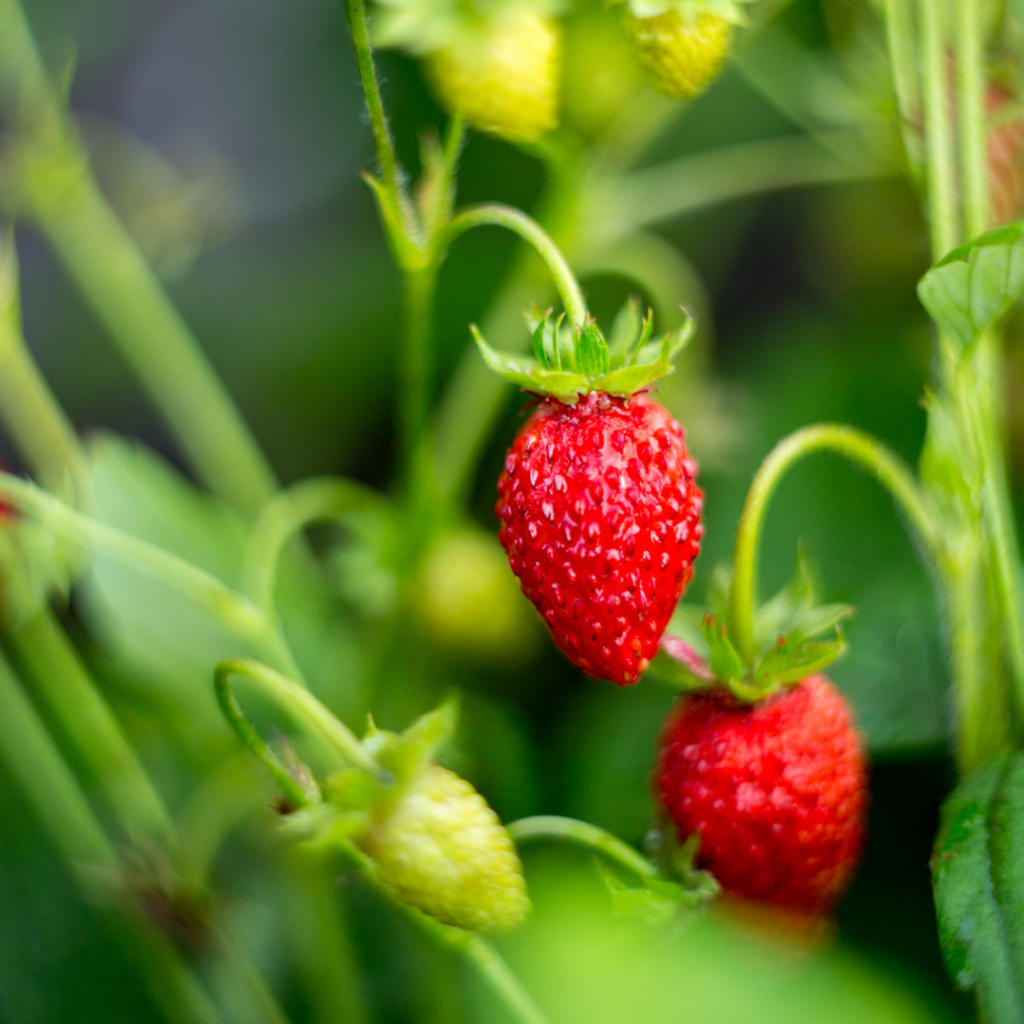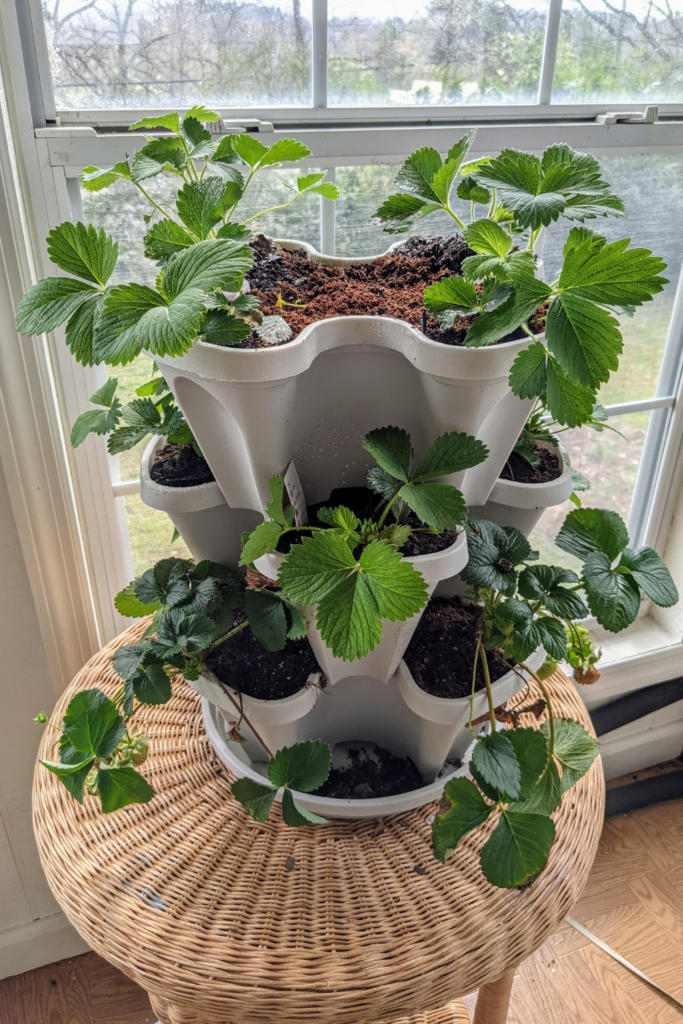How to Grow Strawberries Indoors may be more simple than you think.
Growing strawberries indoors is the best way for many strawberry varieties to grow, especially when you are limited on outdoor space. Here’s how to grow your own strawberries indoors. I’ve included a video for you visual learners!
Ripe strawberries are so delicious! If you have only ever had them from a grocery store then you are missing out. Fresh strawberries with their bright red color are a whole different kind of delicious fruit.
The first year that I decided to grow strawberries, I grew them in my outdoor garden. They simply didn’t work well for me. I couldn’t seem to keep the pests off of them. The deep red color must have called to them. I can’t blame those little pests! Between the birds and spider mites, I didn’t have much of a harvest. Strawberries are my favorite too. I’ve had better luck with indoor strawberries.
Types of Strawberries
Step One: pick your strawberries. There are three main types of strawberries. The June-bearing, ever-bearing, and day-neutral varieties.
June-Bearing: typically produces one big crop in June. Great for canning and making jellies and jams with the abundance of fruit.
Ever-Bearing: These plants start producing in the summer and continue to produce throughout the summer months. Great if you want fresh strawberries throughout the growing season.
Day-Neutral: Instead of producing consistently, these typically produce three main yields around once per month in the summertime.
Alpine strawberries are the wild strawberry variety, also known as the woodland strawberry. They produce smaller fruit but are bursting with flavor. Some consider them the “mountain variety” of strawberries and they make for excellent ground cover. These would be considered ever-bearing as they bear well throughout the summer months.

How to Grow Strawberries Indoors
You could certainly plant strawberry seeds instead of strawberry seedlings or starter plants. If you do this, be sure to pinch off the first crop of strawberry growth. This will ensure a bigger, juicier crop the next time and stronger root development.
Strawberry starter plants can be planted anytime year-round for indoor planting. However, it will be much easier to find starter plants to purchase in early spring. They will take approximately 5-6 weeks to begin to fruit. Strawberry seeds will take approximately 6 months before you see the first fruit.
This time I went with Quinault varieties of strawberries. This is an everbearing strawberry variety. Previously I went with June-bearing strawberries. I would still recommend you plant some of both so you have plenty of strawberries all summer long. The type of strawberry you plant is a personal preference. I love having an early summer crop.
Should I use a grow light for strawberries?
Indoor strawberry plants love full sun and much light. If you don’t have a sunny windowsill for your indoor plants, then a grow light would be a great option for you. This grow light is a great one. Keep in mind that you can make your own grow light, but it needs to be with full-spectrum bulbs.
Strawberries prefer at least 6 hours of direct sunlight, but artificial light can make up for this time.
Soil is important! Coco Loco is amazing soil. It’s my favorite, but it can be pricey. Strawberries also like organic fertilizer with their potting soil. If you can, go for the coco loco, but if not here’s a great alternative: Use coconut coir mixed in with a high-quality potting mix. You could also use peat moss instead of coconut coir. Strawberries like organic matter or organic compost so it’s important to work some in. Quality soil matters!
Strawberries have a shallow root system so they don’t need much room to spread out. This is one reason indoor planting in containers and small spaces works well for strawberries. Here’s the container I chose to use.
The best thing for the different varieties of strawberry plants is moisture and the right amount of light. Strawberries love moisture so plan on watering them at least twice a week. If the top of the soil feels dry, water them. Even placing them from time to time in a humid place, like a bathroom while showering is a big help for them.
How to Grow Strawberries Indoors
- A strawberry container, or planter
- Coco Loco Soil (or quality potting soil mixed with about 1 cup coconut coir)
- Water spray bottle or Irrigation bottle
- Strawberry starter plants (from your local nursery or home store, like Lowes)
Moisten your soil by watering it before planting. Place handfuls of soil into your container, leaving a hole the size of a small fist for your strawberry plants. Loosen the soil from the bottom of your strawberry plant gently and place it in the hole you created.
Make sure the plant sits slightly above the surface of your container so it can hang its strawberry fruit over the side. In other words, don’t bury it too deep. The stems should not be in the soil. Continue until all of your strawberries are planted.

Spray your soil until it is moist, but not soaking. Place your container in a sunny window. Plan to water your strawberries 2-3 times a week. You can tell if they need water by putting your finger one inch in the soil. If it’s dry, water them.
Strawberry fruit does not love laying on the soil. Let them hang if possible over the sides of the planter.
How to Hand Pollinate Strawberries
Personally, I will place my strawberries outside in full sun if I know we will have pretty weather for a few days so the bees have a chance to help with pollination.
Strawberries do need to be pollinated. If your plants are indoors all the time, you can do this by hand. Simply take a q-tip (cotton swab) or a small paintbrush and gently rub the pollen from the outer edge of the flower into the inner part of the flower. This will cause the male and female parts of the flower to pollinate. You need to do this with each flower.
How to Harvest Indoor Strawberries
When the strawberries are fully red in color with no white on the berries, they are ready to be picked. You can simply pull the fruit gently from the plant or use scissors and cut them with a bit of the stem. Strawberries will not continue to ripen after being picked, so be sure to harvest when they are fully ripe.
Happy Indoor Gardening!
Post may contain affiliate links
